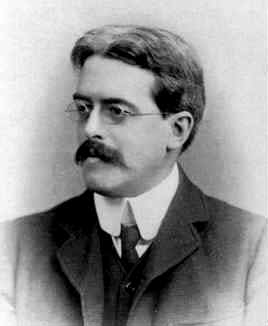.
Thomas John I'Anson Bromwich
Thomas John I'Anson Bromwich (1875–1929) was an English mathematician, and a Fellow of the Royal Society.[1] His third name begins with an uppercase i, as opposed to the lowercase L which would seem more likely.

Thomas John I'Anson Bromwich
Life
Thomas John I'Anson Bromwich was born on February 8, 1875, in Wolverhampton, England. His parents emigrated to South Africa, where in 1892 he graduated from high school. He attended St. John’s College at Cambridge, where in 1895 he became Senior Wrangler.[2] In 1897, he became a lecturer at St. John’s. From 1902 to 1907, he was a professor of mathematics at Queen’s College, Galway. In 1906, he was elected a Fellow of the Royal Society. In 1907, he returned to Cambridge and again became a Fellow and lecturer at St. John’s. He was a vice president of the Royal Society in 1919 and 1920. He died in Northampton on August 24, 1929, a suicide.[1]
Work
Bromwich worked in both algebra and analysis. G. H. Hardy called him "The best pure mathematician among the applied mathematicians at Cambridge, and the best applied mathematician among the pure mathematicians". [1]
Today, Bromwich is perhaps best known for justifying Oliver Heaviside's operator calculus.[3] Part of this involved using a contour integral to do an inverse Laplace transform. This particular contour integral is now often called the Bromwich integral, although it is also called by other names.
Other topics Bromwich investigated include solutions of the Maxwell's equations, and the scattering of electromagnetic plane waves by spheres. He also investigated, and wrote a book on, the theory of quadratic forms.[4]
In 1908 he wrote An introduction to the theory of infinite series. A second edition appeared in 1926. G. H. Hardy praised the book highly, while criticizing the way in which it was laid out. [1] The book is still in print.[5]
Notes
^ a b c d Hardy, G. H. (1930). "Thomas John I'Anson Bromwich". Journal of the London Mathematical Society 5 (3): 209–220. doi:10.1112/jlms/s1-5.3.209.
^ Venn, J.; Venn, J. A., eds. (1922–1958). "Bromwich, Thomas John I'Anson". Alumni Cantabrigienses (10 vols) (online ed.). Cambridge University Press.
^ Jeffries, Harold (1929). "Bromwich's Work on Operational Methods". Journal of the London Mathematical Society 3: 220–223.
^ Bocher, Maxime (1908). "Review: T. J. I' A. Bromwich, Quadratic Forms and their Classification by Means of Invariant Factors". Bulletin of the American Mathematical Society 14 (4): 194–195. doi:10.1090/S0002-9904-1908-01579-9. Retrieved 2008-12-04.
^ Bromwich, Thomas John I'Anson (1926). An introduction to the theory of infinite series. American Mathematical Society Chelsea Publishing. ISBN 978-0828403351. Here is the publisher's description
External links
O'Connor, John J.; Robertson, Edmund F., "Thomas John I'Anson Bromwich", MacTutor History of Mathematics archive, University of St Andrews, retrieved 2008-12-05.
Retrieved from "http://en.wikipedia.org/"
All text is available under the terms of the GNU Free Documentation License

